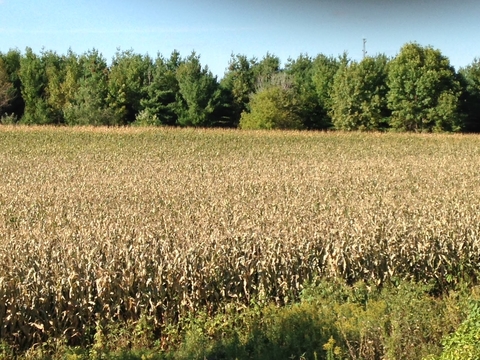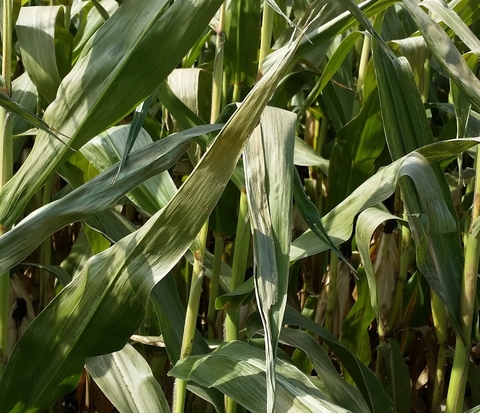Freezing temperatures prior to corn maturity can mean yield loss for corn producers, although the severity of freeze damage greatly varies based on local climate conditions, crop maturity and topographical features.
A corn killing freeze occurs when temperatures dip to 32 degrees Fahrenheit for four hours or 28 degrees for minutes. A killing freeze can still happen with temperatures above 32, especially in low and unprotected areas when there’s no wind.
Symptoms of freeze damage and severity
Freezing temperatures more easily damage corn leaves than stalks. In addition, leaves above the ears are more susceptible to injury than leaves below the ear.
Freeze-damaged leaves initially appear water-soaked (Figure 2). They’re light green to gray after drying and later turn brown.
Wait a few days before scouting fields to assess the freeze’s impact. If the freeze injury is not severe enough to cause the kernel black layer to prematurely form, kernels will continue to accumulate dry matter by translocating sugars from the stalk and remaining green leaf area.
How a freeze affects corn
Due to the variable nature of a natural freeze, yield loss estimates are quite difficult to come by. Yield and quality reductions depend on the crop stage when the freeze occurs and the its severity.
Freeze damage to corn reduces grain and silage yields, grain test weight and silage quality (Table 1). If a freeze damages leaves above the ear, but leaves below the ear are unharmed, then expect yield losses slightly less than those listed in Table 1, which only shows leaf damage.
Photos: How to tell a corn plant’s development stage and whether it’s reached black layer
Table 1: Impact of freeze damage on corn yield and moisture
| Corn kernel stage | Leaves and stalk damaged by a freeze1: Silage yield loss | Leaves and stalk damaged by a freeze1: Grain yield loss | Only leaves damaged by a freeze2: Grain yield loss | Test weight3 | Grain moisture4 | Whole plant moisture5 |
|---|---|---|---|---|---|---|
| R4 (dough) | 30% | 66% | 41% | --- | 70% | 76% |
| R5 (dent) | 21% | 55% | 23% | 47 lbs. per bushel | 60% | 73% |
| R5.25 (75% milk) | 15% | 35% | 18% | 50 lbs. per bushel | 52% | 68% |
| R5.5 (50% milk) | 5% | 10% | 5% | 53 lbs. per bushel | 40% | 66% |
| R5.75 (25% milk) | 1% | 3% | 2% | 54-55 lbs. per bushel | 37% | 63% |
| R6 (mature) | 0% | 0% | 0% | 56 lbs. per bushel | 32% | 60% |
Severely frost-damaged corn often has kernels more susceptible to cracking, grain that’s less digestible and silage with less energy (starch) and more fiber than normal. Monitor grain with severe frost damage and light test weight for mycotoxins before feeding to livestock.
Table 2 lists typical in-field dry-down rates for corn grain in Minnesota.
If a killing freeze occurs at the R5 stage (dent and 60 percent grain moisture) on Sept. 15, then that corn is expected to have more than 38% grain moisture on Nov. 1. In comparison, if a killing freeze occurs at the R5.5 stage (half milk and 40% grain moisture) on Sept. 15, then that corn is expected to reach between 22.5 and 27.5% grain moisture on Oct. 6.
Fields where the husks were green and tightly wrapped around the ears when the killing freeze happens will dry slowly. Monitor ears in those fields for mold. In contrast, corn that’s more advanced in maturity (husks opening up and turning brown) at the time of the frost will dry more normally.
Table 2: Field drying rates for Minnesota corn
| Date | Daily grain moisture loss |
|---|---|
| Sept. 15 to 25 | 0.75 to 1.00% |
| Sept. 26 to Oct. 5 | 0.50 to 0.75% |
| Oct. 6 to 15 | 0.25 to 0.50% |
| Oct. 16 to 31 | 0.00 to 0.33% |
| After Oct. 31 | Very little |
Abendroth, L.J., Elmore, R.W., Boyer, M.J., & Marlay, S.K. (2011). Corn growth and development. Iowa State University.
Carter, P.R. & Hesterman, O.B. (1990). Handling corn damaged by autumn frost.
Hicks, D.R. (2004). Corn test weight changes during drying. University of Minnesota.
Lauer, J. (2011). Frost.
Lauer, J. (1996). Corn harvest in Wisconsin during cool growing conditions. University of Wisconsin.
Nielson, R.L. Risk of fall frost injury to immature corn grain.
Vorst, J.V. (1990). Assessing hail damage to corn.
Reviewed in 2021



